Pro Tool Reviews
-
Build Quality
-
Testing Modes
-
Interface
-
Performance
-
Value
Final Thoughts
The Power Probe IV Automotive Diagnostic Tool is a robust device that will save you time and effort in the pursuit of the fix. It can replace – and improve upon – several diagnostic tools in your shop.
User Review
( votes)Diagnosing automotive problems can be a challenge even after decades of experience. Over time we get a better idea of where to start, of course, but that’s only half the battle. Advances in technology and the compactness of physical design call for more sophisticated tools. Simple tools like the Monster Digital Circuit Tester can be helpful but limitations of the tool are quickly reached. Automotive Pros need to measure what can’t be seen – without tearing a car apart – and find alternative ways to isolate problems like open circuits, voltage drops, and component malfunctions. The fourth generation of Power Probe – the Power Probe IV Automotive Diagnostic Tool – is designed to be just such a tool. Part multimeter, part sensor, and part power source with a big, bright interface, I hope the IV will help boost productivity around the shop. Let’s take it for a test drive.
Key Features
Modes Galore
The Power Probe IV Automotive Diagnostic Tool is powered by 12 and 24 VDC electrical systems. It boasts eight different test modes for those systems:
- VDC Mode – This mode tests DC Voltages.
- Feed Test Mode – Use this mode to check voltages on static circuits or voltage drops on active circuits.
- ACRMS – This mode tests AC Voltages where an RMS measurement is needed.
- P-P – Measure Peak-to-Peak AC Voltages.
- Hrz Frq Cntr – Hertz Frequency Counter for measure AC signals. I’d like to buy a vowel.
[adsenseyu1]
- Fuel Inj Mode – Use this mode for Fuel Injector Circuit testing.
- Drv Test Mode – Test the transistors inside the modules with this mode.
- PPECT Mode – Use this mode for locating open circuits.
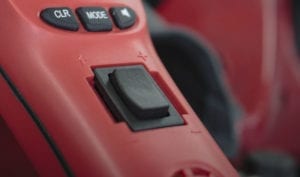 Here’s a Tip: Keep on Rockin’
Here’s a Tip: Keep on Rockin’
The removable Probe Tip uses a 4mm banana connector that will also accommodate other probes, leads, and extensions. The Probe Tip in conjunction with the black Rocker Switch applies battery power (when pressed forward) or battery ground (when pressed backward) in either of the DC voltage modes.
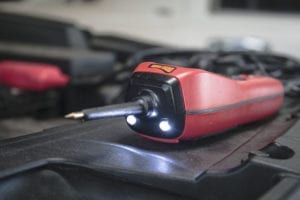 LED Me to the Problem
LED Me to the Problem
A green LED indicates a path to ground but won’t illuminate with more than 10Ω resistance and/or more than 0.5 volts on a ground circuit. A red LED indicates battery positive but won’t illuminate if the voltage drop is more than 0.5 volts from the battery voltage.
Button Up
The left button, labeled CLR, clears minimum and maximum values in voltmeter modes and scrolls up when there’s a menu. The right button, with a speaker icon, toggles the sound and scrolls down when there’s a menu. As the name on the middle button – MODE – suggests, it selects among the test modes.
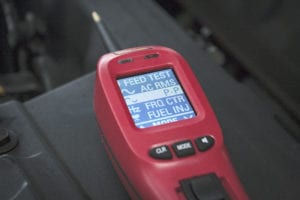 In Your Interface
In Your Interface
A big, bright LCD interface displays several pieces of information in each mode. For example, in all voltage measuring modes, the interface shows the current voltage as the largest number and the minimum and maximum values as smaller numbers at the bottom of the screen. In Frequency mode, you’ll see the current frequency as well as positive and negative pulse widths. These range values are quite helpful as you’ll read in the performance section.
Other Notable Features
Remarkably bright LED work lights at the probe’s base are always on to illuminate the work. Under the black cover on the Power Probe IV Automotive Diagnostic Tool’s back is an auto-resetting, replaceable circuit breaker. And the green auxiliary ground lead has a 20 amp fuse in case it touches battery positive.
I predict that the 23-foot cord will be indispensable as the IV’s power comes from the battery but diagnostics might be done anywhere around the vehicle.
Performance
I’ve used the Power Probe IV Automotive Diagnostic Tool around the shop for several weeks and it’s been impressively helpful. I still feel like I haven’t pushed it to its full potential yet. I got a good sense for each mode but depending on the work you do, you may rely more heavily on a few of the modes while the rest are dormant. Here are some of the most useful things I found.
Manual Labor
Only after I used the very user-friendly manual did I read other reviewers’ praise of it, too. It walks you through the modes and operation simplistically which helps you get more out of the tool. Trying to decipher jargon or poor instructions is difficult enough when you have time to sit down and read. But when the jobs start piling up behind you because you’re trying to reinvent the wheel (pun!), you quickly lose motivation to use the tool. And especially if you’re not performing these operations every day, you can quickly refer to the manual.
 Power Up
Power Up
Finding the problem in an electrical system is a game of ambiguity. The IV can give you the edge to win the game. Let’s say a vehicle comes into the shop and the power window isn’t working (true story). Is it the fuse? The driver’s switch? The passengers? A lockout switch? The component motor? The power probe helps you determine the problem before you tear the whole car apart for the answer.
This is really the genius of the Probe and what first piqued my interest. Although it’s not a power source itself, it conducts the battery’s power to the probe tip. In either of the DC modes, you can operate small motors by applying the tip and pushing the button forward (battery power) and backward (battery ground). In this way, you can isolate the problem at the motor or elsewhere in the circuit.
A customer brought his Jeep into the shop because a windshield wiper was inoperable. Late summer in Florida – not the time to have a bum wiper! I used this feature to diagnose the problem as one of circuitry because I could operate the wiper by applying power from the Probe. It was very cool.
Later I diagnosed a brakelight pedal feed problem, too.
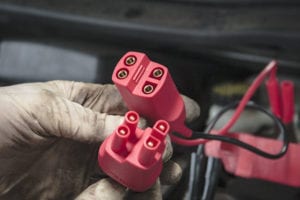 Lethal Injections
Lethal Injections
Another project came into the shop: A 2010 Lincoln with a bad injector – except I didn’t know that was the problem. In fact, it’s not that common so it’s probably not where I’d begin. Often it could be a spark plug or something else. But since the Power Probe IV Automotive Diagnostic Tool makes it so easy, I used the injector pulse test. I tapped into the injector’s pulse feed with the probe. The LEDs blink to indicate if and how the injector’s pulsing because they are synchronized with the injector is pulsing from the ECM. The vehicle’s processor opens and closes the circuit and that’s what you’re monitoring with the Probe. If you didn’t have the IV, you’d use a noid light or meter that would need to indicate a really fast, small pulse.
Twin Peaks
The P-P mode, or peak-to-peak, is particularly helpful for knowing maximum and minimum voltage readings. It’s nice to be able to measure battery voltage right at the battery but sometimes measuring static voltage isn’t enough. Let’s say you want visibility of what’s happening to the voltage as the car starts. By using the P-P Mode, you can see the current voltage as well as how low and high the voltage reached.
[adsenseyu2]
 The Bottom Line
The Bottom Line
The Power Probe IV Automotive Diagnostic Tool is a powerful device for Automotive Pros that can, in many cases, replace a multi meter, test light, noid light, test lead set, and perhaps more. It can detect problems that would otherwise take much more effort, or more tools, or both to identify. It eliminates ambiguity in measurements with its light and sound indicators. Brilliantly, it stores information that you couldn’t capture since you can’t be in two places at once!
I suspect you could employ the IV for quite a while and still find new uses for it. Some might complain that the auxiliary ground lead flops around and gets in the way, but I didn’t really have a problem with it. Otherwise, I’d be hard-pressed to gripe about anything about Probe. At $160, it’s an inexpensive diagnostic tool that will quickly pay for itself!
To get your Power Probe IV diagnostic tool now, click here.
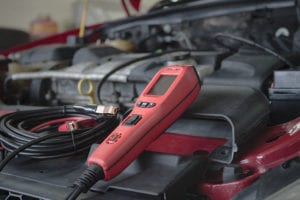 Power Probe IV Automotive Diagnostic Tool Features
Power Probe IV Automotive Diagnostic Tool Features
- 8 modes including VDC, Feed Test, ACRMS, P-P, Hertz Frequency Counter, Fuel Injector, Driver Test, and PPECT
- Gold-plated 4mm banana jack
- Easy to see LCD Display in direct sunlight
- Large Color LCD Screen with Easy to Navigate User Menu
- Supplies battery power and ground
- 23 Foot Battery Power Supply Cable
- Bright White LED’s Flashlight for increased visibility
- Self-resetting and replaceable circuit breaker
- Ergonomic Handle Design
- AC/DC Voltmeter
- Ohmeter
- Frequency
- Pulsewidth (Positive and Negative)
Power Probe IV Automotive Diagnostic Tool Specifications
- Item number: PP401AS
- 12-24 volt range
- Min Operating Voltage: 8 VDC
- Max Operating Voltage: 30 VDC
- Max Tip Voltage: 450 Volts
- Probe Tip Resistance to Ground: 350 K Ohms
- Computer Safe: 0.1mA floating tip
- Voltage Measurement: -100 to 200 VDC / VAC
- Voltage Resolution: -99.99 to 99.9 V – 0.01V (10mV) 100.0 to 199.9 V – 0.1V (100mV)
- Glitch Capture: >380µS Min Pulse Width
- Power Feed Test: < 30 mA
- Resistance Measurement: 0.1 Ohms to 10K Ohms
- Frequency Measurement: 1Hz to 9999Hz
- Driver Test: 50 Ohm Pull Up on Tip
- Green LED and Tone when < 1 Volt
- ECT Signal Detection: 2 sec.
- Fuel Injector Mode: LED Flash @ Min 35V @ 100µS Pulse
- Red LED Response: Within 0.5V BATT V in Voltmeter
- Mode and < 10 Ohms in Power
- Feed Test Mode
- Green LED Response: < 10 Ohms in both Power Feed Test
- Mode and Voltmeter Mode
- Circuit Breaker: 8 Amp Thermal – Auto Reset
- Breaker Trip Response: 8 Amps = No Trip
- 10 Amps = 20 min.
- 15 Amps = 6 sec.
- 25 Amps = 2 sec.
- Short Circuit = 0.3 sec.
- Operating Temperature: -20°C (-4°F) to 50°C (122°F)
- Storage Temperature: -40°C (-40°F) to 65°C (149°F)
- Price: $160
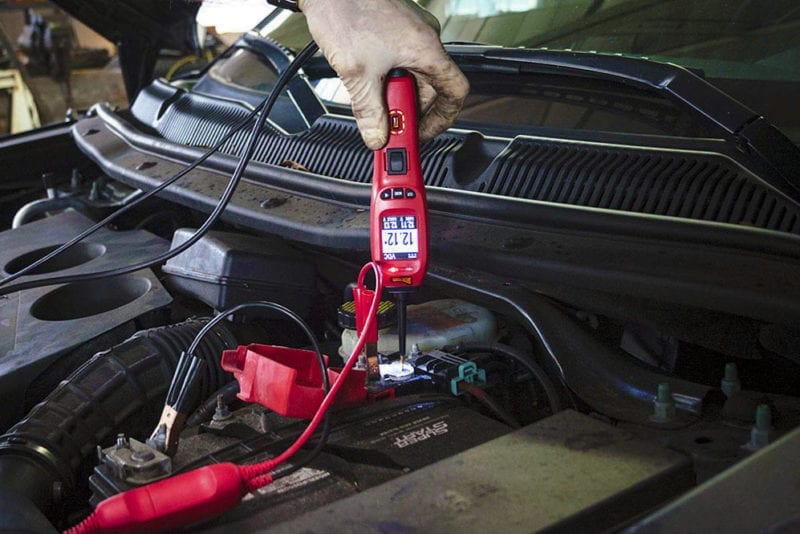
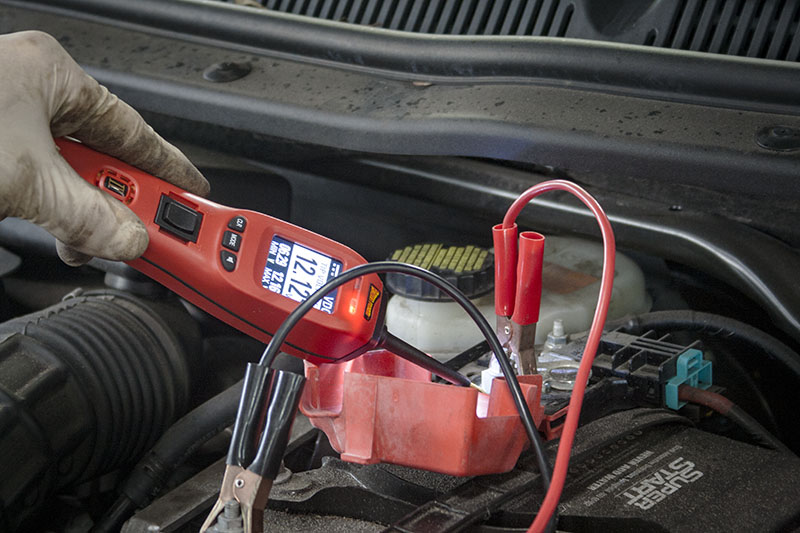



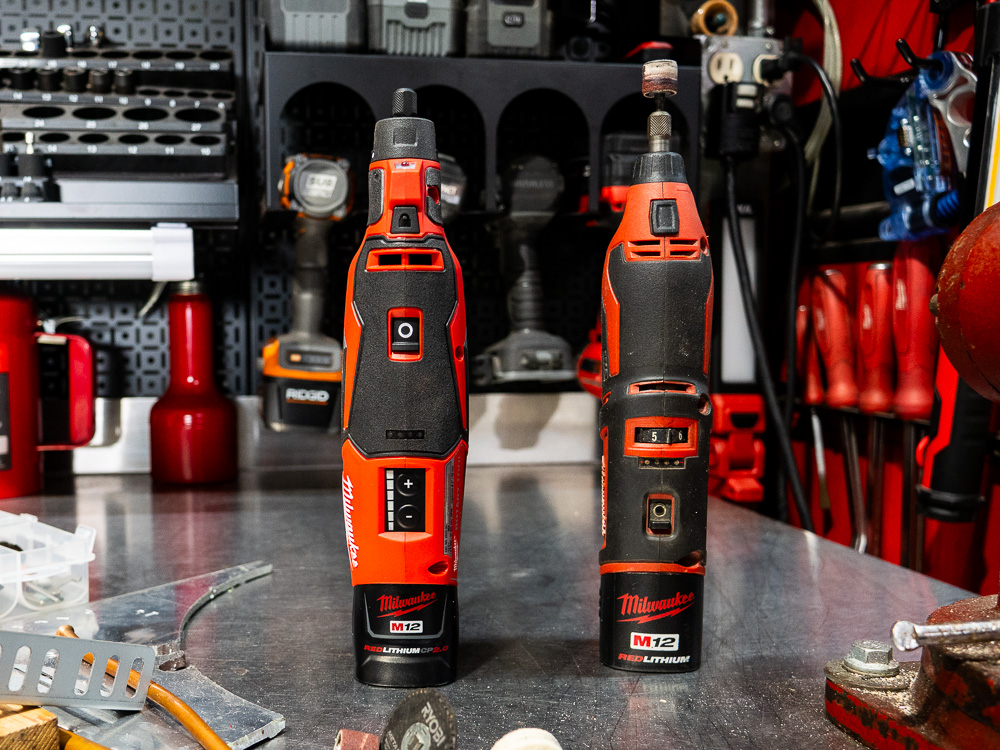



Leave a Reply